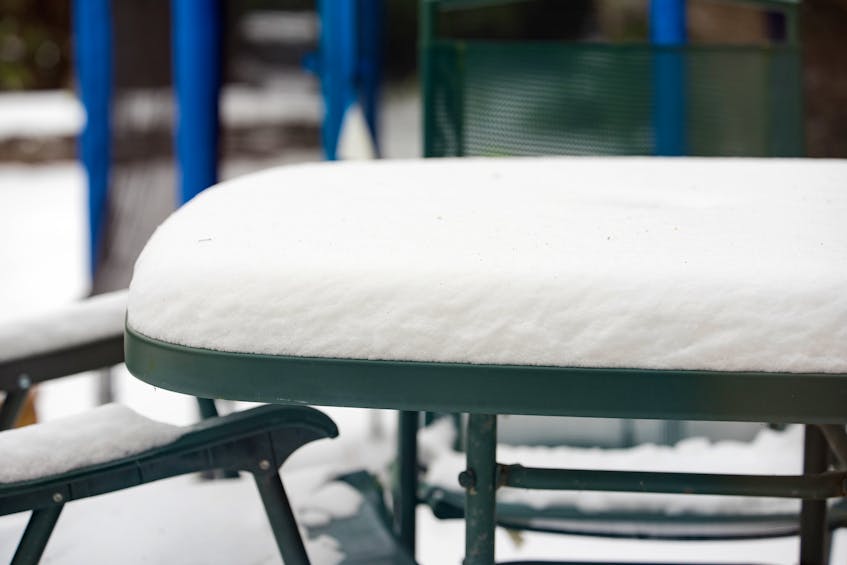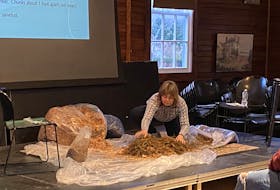Kate Dalton has learned an expensive lesson.
Most people leave their lawnmowers in the garage for the winter, but if yours is an electric one with a rechargeable battery, don’t leave the battery in a cold garage all winter, says the Wolfville, N.S. resident. This kills the battery beyond resuscitation, and it can be over $200 to just replace the battery.
When it comes to storing your lawnmower for the winter, Ray Savage of No Job Too Small Handyman Services, based in Aylesford, N.S., says to start by cleaning any leaves or debris off your mower and scrape off any caked-on grass from under the mower deck. If you don’t, that stuck-on debris will hold moisture and contribute to your mower deck deteriorating prematurely.

If you have a ride on mower, Savage says it’s important to fully charge your battery, remove it and store it in a cool, dry, non-freezing location. On a shelf in your basement would be ideal, but don’t leave it on the concrete floor, he warns, as the concrete may drain the battery.
Then, Savage says, fill the mower’s fuel tank with fresh, premium fuel with an added fuel stabilizer, such as STA-BIL. Start the mower and let run it for a few minutes to get the fresh fuel and stabilizer into the carburetor. This will help ensure that the carburetor doesn’t gum up and sludge and tar don’t form in the fuel tank.
Finally, Savage says, store your mower in a cool, dry place, such as a shed or garage.
Storing Barbecues

Barbecues make a great winter home for mice, as the cover gives them a great roof and little tidbits of burned meat for food, says Savage. You can, however, help make it less attractive to mice before storing it for the cold season.
Give your grates and burners a good scrapping with your grill cleaner and scrape the sides of inside the barbecue with a putty knife. Move the scrapings into the grease tray and then dispose of them in your green bin, he says.
Barbecues are built to withstand the great outdoors and some folks like to use them over the winter months, says Savage. You can also choose to use a grill cover or a tarp to help protect it. If you use a tarp, ensure it is tied down and it is a couple of inches off the ground to promote air circulation, explains Savage.
If you don’t plan on grilling in January, store your barbecue in a cool, dry location like a garden shed or garage.
David Rossiter, provincial fire marshal for the Province of P.E.I., says barbecue tanks should be stored in a separate building, such as a baby barn or shed, and not in your basement or a garage attached to the home. You can opt to leave the tank attached to the barbecue, says Rossiter, as long as it’s not in the home.
Alternatively, he says, barbecue tanks can be stored on the deck, upright, but should be covered with a tarp to protect the tank’s connections and relief valve from dirt and moisture.
Patio Furniture
Patio furniture, much like barbecues, is constructed for outdoor environments. Cold temperatures could make plastics and vinyl more prone to splitting, however.
When storing outside, you may choose to put it under your deck or cover it with exterior furniture covers or a tarp. If using a tarp, ensure it’s well tied down and a couple of inches off the ground for air circulation, says Savage.
You can also opt to store patio furniture inside the house or in your garage or shed.
Preventing Rodents

According to Richard MacDonald, owner of Cape Breton Pest Control, it’s hard to prevent mice and rats from entering sheds and garages because they can enter through the tiniest openings. Mice can enter in a gap that’s just one-quarter inch big, while rats can enter into a dwelling with just a half-inch of space. Squirrels and raccoons are other possible unwanted visitors, he adds.
To the best of your ability, MacDonald recommends sealing any exterior openings in buildings with materials like steel wool, heavy-duty caulk, concrete, or wood. Spray foam, he says, isn’t the best option - it can be easily gnawed by rodents.
“It is very important that you remove any sources of food, like pet food, birdseed, grass seed, etc., from outbuildings and garages or store them in a sealed, heavy-duty plastic container,” he adds.
MacDonald says it is important to use heavy-duty sealed plastic totes or secure boxes to store items that are vulnerable to rodent activity. Rodents will enter structures such as homes, sheds, or garages during colder months and seek out items for food and nesting materials, he says.
Common items that get contaminated or destroyed by rodents are patio cushions, Christmas decorations, grass seed, and birdseed, he explains.
While hard-surfaced items can be cleaned of rodent droppings with a disinfectant cleaner or solution of 10 per cent bleach mixed with water while using the proper personal protective equipment, including mask and gloves, MacDonald says some surfaces like cushions, may be harder to properly clean and must be thrown out.
Gardening Tools

At the end of the gardening season, Delcie Lee of Botwood, N.L., makes it a priority to clean up her gardening tools.
She starts by cleaning them with dish detergent, lets them dry, then drenches them in canola oil. Afterward, Lee says, she lays the tools on paper towels to let the oil soak into all the moving parts. Finally, she wipes off the excess oil before storing them for the winter.
Becky Boutilier, a red seal horticulturist with Clintar Landscape Management in Dartmouth, N.S. offers some similar advice for garden tool storage.
In the late fall, after she has finished planting her garlic and fall bulbs, Boutilier pressure washes all her hand tools and then uses a wire or straw brush to ensure the removal of all pathogens that may be lingering.
Once the metal surfaces are free of debris, use a bleach solution and wipe the tools off, she says. Once this is complete, the tools should be wiped dry and oiled. Boutilier likes using a plant-based product, such as vegetable oil, olive oil, or tea tree oil.
Sharpening any tools should always be done before the oil gets put on to help prevent winter rust from taking hold.
“It is not always necessary to buy new tools - just repair the ones you have and save a few bucks."
If possible, it’s best to store your tools in a dry area without exposure to the elements, says Boutilier. If that is not possible, place larger tools - such as shovels, edgers, and rakes - under a deck or shed, but set them on top of a piece of lumber to avoid contact with soils and water.
“You should really try and keep your smaller tools like pruners, garden knives, and sheers inside,” she says.
It’s important to also pay attention to the state of the handles on tools, says Boutilier.
“The last thing you want is a nasty splinter or a broken handle poking you when you start spring garden work,” says Boutilier.
Help avoid this with a simple inspection of all handles. If you find they show wear, use sandpaper to smooth them out; if they are cracked, look at replacing them.
“It is not always necessary to buy new tools - just repair the ones you have and save a few bucks,” she says.
Another good practice is emptying and disinfecting planters, says Boutilier. It’s best to fill pots and baskets with new soil each year.
If your planter is a hard plastic or ceramic one, it will likely split and break during the winter if left full of soil and outdoors, she says. She suggests storing them inside or at least emptying them.
If you have rubber, concrete, or flexible resin planters, it’s always nice to leave the soil in, and make a winter display using fir, paper birch, dogwood, pine, and holly, suggests Boutilier. Simply place the boughs in the soil then water it. Once the soil freezes, the material becomes very stable - just don’t forget to replace the soil in the spring.









